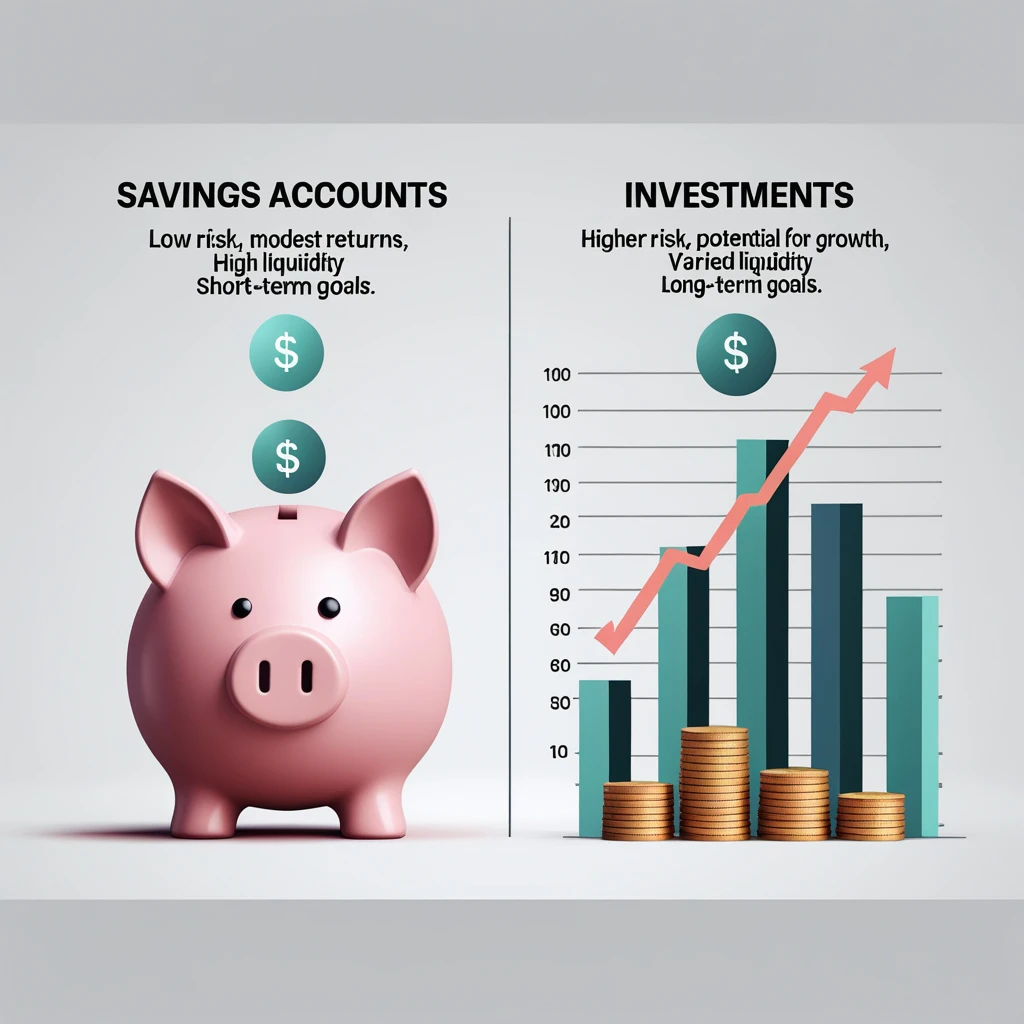Have you ever found yourself at a crossroads, trying to decide whether to save your money in a secure savings account or take the plunge into the world of investments? This decision marks a crucial juncture in personal financial planning, reflecting a balance between security and risk. With rising living costs and economic uncertainty, understanding the distinct roles of savings accounts and investments becomes imperative. Savings accounts offer a haven of security, guaranteeing nominal returns and easy liquidity, suitable for short-term goals or emergency funds. On the other hand, investing exposes you to the potential for greater growth at the cost of higher risk, making it attractive for long-term objectives such as retirement. This article seeks to demystify the nuances of savings accounts versus investments, aiding you in making informed financial decisions that align with your goals and risk tolerance.
Comparing Savings Accounts and Investments

Savings accounts and investments serve distinct purposes within a financial strategy. Savings accounts are financial products offered by banks or credit unions, designed to store cash safely. They usually yield interest, albeit at lower rates compared to potential investment returns. They provide safety through deposit insurance, such as the FDIC in the United States, and liquidity for easy access to funds. Conversely, investments encompass a wider spectrum, including stocks, bonds, mutual funds, and real estate, offering variable returns based on market performance, often exceeding those of savings accounts over the long term. Investments, however, carry inherent risks of loss, particularly if market conditions fluctuate unfavorably. Here’s a concise comparison:
| Aspect | Savings Account | Investment |
|---|---|---|
| Risk | Low | Variable (Low to High) |
| Return | Low | Potentially High |
| Liquidity | High | Variable |
| Security | Insured | Not Insured |
| Time Horizon | Short-Term | Medium to Long-Term |
Savings accounts prioritize the preservation of capital, ideal for individuals seeking financial security with minimal risk. Investments, on the other hand, aim for growth in capital, requiring a willingness to endure market fluctuations.
Understanding Investment Risks and Returns
The key to navigating investments is understanding their correlation between risk and potential returns. Stocks, for instance, can offer substantial returns but are subject to market volatility; their value can fluctuate dramatically in short periods. Bonds present moderate risk, as they are debt securities issued by corporations or governments, generally providing fixed interest payments, hence more stable than stocks. Mutual funds and index funds pool resources from many investors to purchase diversified assets, distributing and consequently reducing individual risk while still offering the possibility of decent returns. Real estate investments offer property ownership with income through rent and property appreciation. Each investment type bears distinct risk and return profiles; choosing the right mix requires evaluating your risk appetite and financial goals.
“In investing, what is comfortable is rarely profitable.” – Robert Arnott
An informed investment plan involves understanding these risks and diversifying to mitigate potential losses. Diversification, spreading investments across various asset classes, minimizes the impact of a poor performing asset on your overall portfolio, ultimately protecting against total loss.
Strategies for New and Cautious Investors
New investors, frequently overshadowed by the fear of loss, tend to veer towards safe options like savings accounts, especially given economic volatility. A prudent strategy for beginners might include dollar-cost averaging, where investments are made at regular intervals rather than in lump sums, reducing the impact of market volatility. 1- Start with a balanced portfolio, integrating bonds for stability alongside a few high-quality stocks for growth. 2- Diversify to hedge against sector-specific downturns; this variation spreads risk. 3- Keep an emergency fund in a savings account before testing the waters of the stock market. 4- Utilize tax-advantaged retirement accounts, such as IRAs and 401(k)s, to harness long-term growth benefits while optimizing tax obligations. Developing a tailored plan requires patience and continuous education, ensuring decisions align with both current financial circumstances and future aspirations.
Utilizing Savings Accounts Efficiently

Despite the allure of investments, savings accounts retain critical roles within financial planning. Their primary function revolves around serving as emergency funds, covering unexpected expenses without the need to liquidate investments at inopportune times, like during market downturns. Emergency funds usually encompass three to six months of living expenses, providing a financial buffer. Savings accounts are also suited for short-term goals, such as saving for a vacation, a new car, or a down payment on a house, where immediate access to funds outweighs potential higher returns from short-term investments. Additionally, ensuring you capitalize on high-yield savings accounts, which reward higher interest rates than traditional savings accounts, can enhance your overall savings strategy, maximizing returns without additional risk.
The Psychological Factor: Risk Tolerance
Investing entails a psychological commitment to risk unknowns and managing emotional responses to market movements. Risk tolerance, a personal measure of the amount of variation in investment returns an individual is willing to withstand, varies from one investor to another. It is influenced by factors including financial goals, time horizon, and past experiences with financial losses. A mismatch between investment choices and risk tolerance often leads to anxiety-driven mistakes, such as panic selling during downturns or impulsive buying at market peaks. Hence, evaluating your risk tolerance through tools like questionnaires or consulting financial advisors is critical before embarking on investing. Tailoring your investment strategy accordingly ensures comfort in market participation, aligning emotional resilience with financial objectives.
Taxes and Regulatory Considerations

Understanding tax implications and regulatory considerations is essential when choosing between savings and investments. Interest from savings accounts is typically taxed as ordinary income and reported annually. Investments, however, encounter varying tax treatments based on asset type and investment duration. Short-term capital gains, realized on assets held for less than a year, are taxed at standard income tax rates, whereas long-term capital gains benefit from reduced taxation. Dividend income from stock investments can also be taxable at different rates, depending on whether dividends are classified as ordinary or qualified. Beyond taxes, staying mindful of regulatory environments governing investments, like the SEC in the United States, ensures compliance and safeguards investor interests. Utilizing tax-advantaged accounts, like retirement accounts or education savings plans, also provides avenues to optimize tax liabilities while growing your investments.
Ethical and Sustainable Investing
Today’s investors increasingly turn towards ethical and sustainable investment practices, reflecting a commitment beyond mere financial returns. This trend involves selecting investments based on environmental, social, and governance (ESG) criteria, ensuring that businesses align with personal values promoting sustainability, social responsibility, and corporate governance excellence. Sustainable investing can include supporting renewable energy projects or companies committed to reducing carbon footprints and promoting fair labor practices. Although often debated concerning return prospective, studies demonstrate that companies adhering to sustainable practices often showcase stronger financial performances over the long-term, driven by efficient operations and positive brand reputation. This alignment of ethical considerations with financial goals reflects a holistic investment approach, resonating with modern values of responsibility and impact investing.
Financial Advisors: Navigating Choices
When faced with the intricate choice between savings accounts and diverse investment options, financial advisors offer a valuable resource for navigating these decisions. Advisors assist in dissecting personal financial situations, outlining potential solutions that align with individual goals, risk tolerance, and market conditions. They can provide insights into market trends, portfolio diversification strategies, and tax-efficient investment solutions, ensuring a well-rounded approach to wealth management. However, understanding the costs, such as transaction fees or advisory service charges, and determining advisor qualification are paramount factors in selecting the right guidance. Whether through independent advisors or employing robo-advisors that automate asset selection through algorithms, leveraging professional assistance can enhance decision-making, providing peace of mind in financial pursuits while fostering informed investment strategies.
FAQ – Common Questions
What is the primary difference between savings accounts and investments?
The main difference is that savings accounts offer secure, low-risk options with limited growth, while investments present higher potential returns at the cost of greater risk.
Can I lose money in a savings account?
While savings accounts are insured, mitigating the risk of loss, they are prone to inflation risk, where purchasing power decreases over time if returns do not keep up with inflation.
How do I determine my risk tolerance?
Risk tolerance can be assessed through quizzes, analyzing investment objectives, and consulting with financial advisors to align your investment choices to your comfort with risk.
Are investments always better than savings for long-term growth?
Investments often outpace savings in long-term growth due to market dynamics, but the better option depends on the individual’s risk tolerance and financial goals.
What is the role of diversification in investments?
Diversification spreads investments across various asset types, minimizing the impact of poor performance of any single asset on the overall portfolio, offering a balanced risk-return tradeoff.
How can I start investing with limited capital?
Begin with low-cost investments like index funds, consider robo-advisors for tailored advice, or invest incrementally through fractional shares and dollar-cost averaging strategies.
Conclusion: Charting Your Financial Course
Choosing between savings accounts and investments is more than just a decision between safety and risk; it’s about aligning financial instruments with your unique financial conditions and future aspirations. While savings accounts provide a secure starting point, offering liquidity and minimal risk for short-term goals and emergencies, investments beckon those aiming for long-term growth, requiring a tolerance for market swings and strategic acumen. Each has a distinct place in a holistic financial strategy, vital for your journey toward financial independence. Balancing these elements, informed by comprehensive understanding and personal financial philosophy, ensures robust preparation for whatever tomorrow might bring, maintaining financial peace and growth across life’s chapters.


